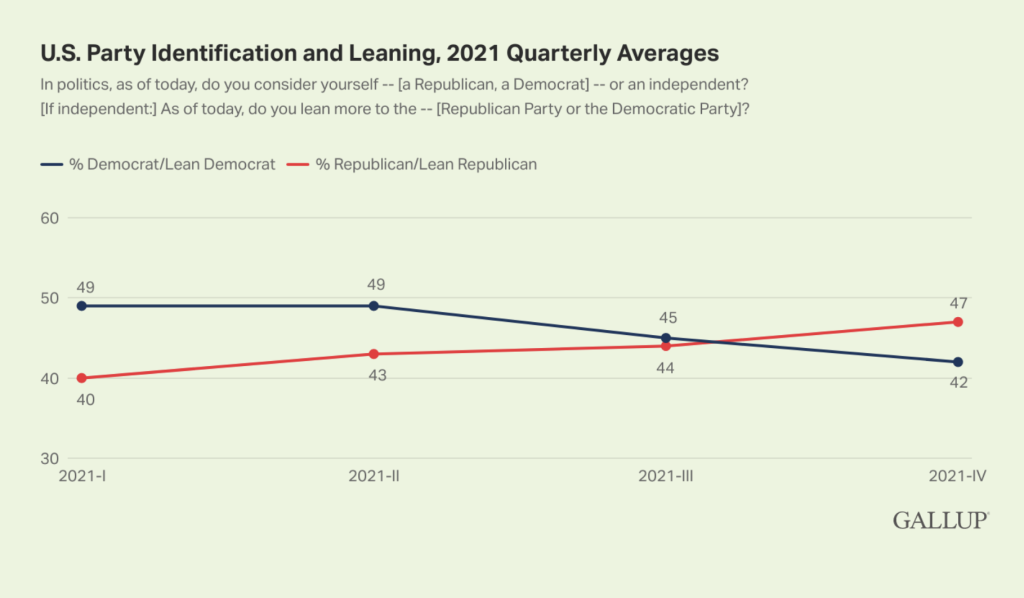The most recent data from Gallup illustrates a dramatic shift among the electorate at the end of 2021. While the year’s average favored Democratic support overall with a 3-point advantage, the fourth quarter of 2021 saw a 5-point advantage for Republican support. (Featured photo by Kelly Sikkema on Unsplash).
The 2021 shift
At the beginning of last year, Democrats held a solid 9-point advantage, with 49% of Americans identifying as Democrats or leaning to the left with 40% identifying as Republican or right-leaning. According to Gallup, this was the Democrat’s largest lead since 2012, when the party held another 9-point lead.
But in the fourth quarter of 2021, Republicans gained a 5-point advantage at 47%, while Democrats dropped to 42%. This shift is especially dramatic given that the Democratic party has usually held the lead. While the two parties had fairly equal levels of support from 2001 to 2003 and in 2010 and 2011, according to Gallup, the last time Republicans held the lead was in 1991.

Affiliation follows presidential approval
The Gallup report suggests that this shift in party affiliation followed changes in presidential approval. Noting President Trump’s lowest approval ratings at the end of his term and Biden’s highest right as the Biden Presidency began, Gallup points to the 9-point gap between the Democrats and Republicans right after the change in office.
Gallup attributes the 7-point drop in Democratic affiliation at the end of 2021 to Biden’s handling of the Delta surge and the withdrawal from Afghanistan. “[Biden’s] ratings remain low as the U.S. battles rising inflation and yet another surge of COVID-19 infections, tied to the omicron variant of the virus,” states the Gallup report.
Independents outnumber Republicans and Democrats
One of the most interesting parts of this report was how Independents outnumber Republicans and Democrats. According to the report, “[T]he largest proportion of Americans identify initially as political independents.”
The “initial” identification refers to Gallup’s surveying method. For example, the data in this particular report came from interviewing 12,000 randomly sampled adults in the U.S. In these interviews, Gallup asks Americans to identify as Democrat, Republican, or Independent. However, those who identify initially as Independent are asked a follow-up question: “whether they lean more toward the Republican or Democratic Party.”
According to Gallup, the American trend towards identifying as Independent started in the late 1980s. But in 2011, 40% of Americans identified as Independent, and that has generally been the case ever since.
Exceptions to this generality are years with presidential elections. “At least four in 10 Americans have considered themselves independents in all years since 2011, except for the 2016 and 2020 presidential election years,” Gallup states.

Last year, 42% of Americans identified as Independents, while only 29% identified as Democrats and 27% as Republican. What’s more, when asked whether they lean left or right, the Independents seemed to be split almost evenly in two. “Roughly equal proportions of independents leaned to the Democratic Party (17%) and to the Republican Party (16%),” Gallup reports.
Author: Bo John Brusco








